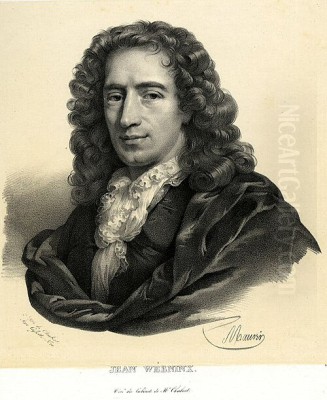
Jan Weenix (c. 1640/1642 – 1719) stands as a prominent figure in the rich tapestry of Dutch Golden Age painting. Renowned primarily for his opulent and meticulously detailed still lifes, particularly those featuring game and hunting trophies, Weenix carved a distinct niche for himself. His work, often characterized by dramatic compositions and a masterful handling of texture and light, appealed greatly to the affluent patrons of his time. Born into an artistic family, he inherited a strong foundation but developed a unique style that blended Dutch precision with an Italianate sensibility, securing his place as one of the leading masters of his chosen genres in the latter half of the 17th and early 18th centuries.
Early Life and Artistic Formation
Jan Weenix was born in Amsterdam around 1640, though some sources suggest 1642. He was immersed in the world of art from his earliest days as the son of Jan Baptist Weenix (1621–c. 1660), a highly respected painter known for his Italianate landscapes and genre scenes. The elder Weenix was undoubtedly Jan's first and most influential teacher, imparting the fundamentals of painting and likely instilling an appreciation for the Italian artistic traditions he himself had absorbed during his time in Rome.
Beyond his father's tutelage, historical accounts suggest Jan Weenix may have also received training from other notable artists. Mentions of Abraham Bloemaert, a leading Utrecht Mannerist and history painter, and Claes Cornelisz Moeyaert, an Amsterdam history painter known for his Rembrandtesque style, appear in connection with his education. This diverse training would have exposed the young Weenix to various artistic currents prevalent in the Netherlands at the time.
A significant step in his professional development came in 1664 when Jan Weenix was registered as a member of the Guild of Saint Luke in Utrecht. Membership in the guild was essential for artists wishing to practice independently, take on pupils, and sell their work legally. This indicates that by his early twenties, Weenix had achieved a recognized level of competence and was ready to embark on his independent career, initially working in Utrecht before later returning to his native Amsterdam.
The Italianate Legacy via Jan Baptist Weenix
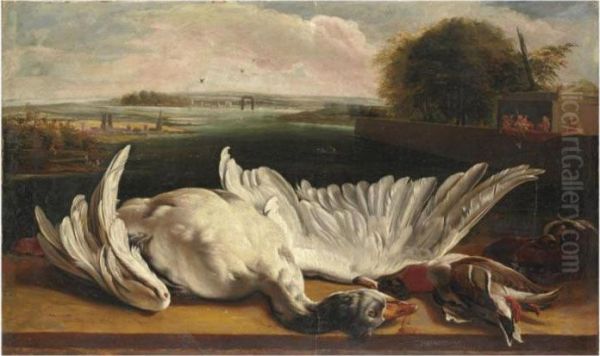
While Jan Weenix himself likely never travelled to Italy, the influence of Italian art, particularly the picturesque landscapes and warm light associated with the Italianate style, permeated his work, largely channelled through his father. Jan Baptist Weenix had spent several years in Italy (c. 1643-1647), primarily in Rome. There, he associated with the Bentvueghels (Dutch for "Birds of a Feather"), a society of mostly Dutch and Flemish artists active in Rome, known for their bohemian lifestyle and mutual support.
During his Italian sojourn, Jan Baptist Weenix absorbed the local atmosphere, studying the Roman Campagna, classical ruins, and the quality of Mediterranean light. He worked for prominent patrons, including Cardinal Camillo Pamphili, nephew of Pope Innocent X. His paintings from this period, and those created upon his return to the Netherlands, featured sunny landscapes, ancient ruins, bustling harbours, and figures clad in peasant or exotic attire, all rendered with a characteristic warmth and luminosity.
Jan Baptist Weenix became a leading figure among the Dutch Italianate painters, a group active mainly in the mid-17th century who specialized in depicting Italian or Italian-inspired landscapes. This circle included artists like Jan Asselijn, known for his sensitive landscapes and animal paintings; Andries Both and his brother Jan Both, who pioneered the idealized Italian landscape; Nicolaes Berchem, Jan Baptist's cousin and another prolific Italianate painter; Pieter van Laer, famous for his Roman street scenes known as bambocciate; and Cornelis van Poelenburg, an earlier master of small-scale Italianate landscapes with mythological or biblical figures. Jan the Younger grew up surrounded by these influences, learning the techniques and appreciating the aesthetic indirectly through his father's work and possibly through interactions with his father's colleagues like Berchem.
Development of a Signature Style
Although Jan Weenix's early works show a clear debt to his father, including some Italianate landscapes and harbour scenes, he soon began to specialize and develop his own distinct artistic personality. His primary focus shifted towards still life painting, particularly elaborate compositions featuring dead game – birds, hares, and occasionally deer – often arranged outdoors in park-like settings or against architectural backdrops. He became the preeminent master of this genre in the Dutch Republic during the late 17th and early 18th centuries.
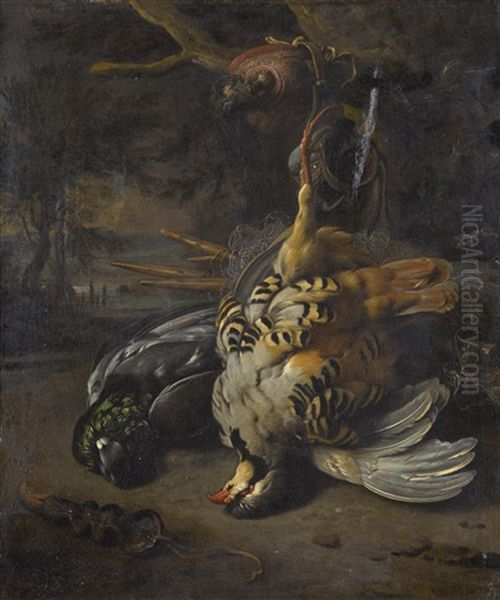
Weenix's style is characterized by an extraordinary technical refinement and meticulous attention to detail. He rendered the textures of fur and feathers with astonishing verisimilitude, capturing the softness of a rabbit's pelt or the intricate patterns and iridescent sheen of a pheasant's plumage. This precision extended to the depiction of foliage, fruits, hunting paraphernalia (such as guns, powder horns, and game bags), and the luxurious objects – silver urns, Turkish carpets, sculpted reliefs – that often adorned his compositions.
His use of colour was rich and sophisticated, often employing deep, resonant tones contrasted with areas of bright illumination. Weenix masterfully manipulated light and shadow, creating dramatic effects that highlighted the central elements of his still lifes and imbued them with a sense of theatricality. While rooted in the Dutch tradition of detailed realism, his compositions often possess a grandeur and decorative elegance that reflects Baroque sensibilities, moving beyond simple inventory to create visually stunning arrangements that spoke of wealth and aristocratic pursuits.
Masterpieces of Still Life and Game
Jan Weenix produced a significant body of work, with many paintings now considered highlights of the still life and game genre. Among his most celebrated works is the Dead Swan (c. 1680s, precise date varies, Rijksmuseum version often cited). This powerful image, often interpreted as an allegory, possibly referencing the political vigilance of the De Witt brothers or simply showcasing the painter's supreme skill, depicts a swan dramatically slumped against a balustrade, its white feathers rendered with breathtaking detail against a darker background. The scale and dramatic presentation elevate the subject beyond mere representation.
Another key work is the Game Piece with a Dead Heron (1695), sometimes titled Still Life with Dead Heron. Examples exist in various collections, including The Metropolitan Museum of Art. These paintings typically showcase Weenix's ability to arrange complex compositions involving multiple types of game birds, often a hare, and hunting dogs, set within lush landscapes or near classical garden ornaments like urns or statues (sometimes depicting Diana, the goddess of the hunt). The spatial depth and the interplay of textures – feathers, fur, stone, foliage – are hallmarks of his mature style.
Weenix often employed preparatory studies and sketches. A notable example relates to the large canvas Still Life with Goose and Game before a Country Estate (Amsterdam Museum). Associated drawings reveal his careful planning of the complex arrangement, studying the poses of the animals and the overall composition before committing to the final painting. This meticulous approach contributed to the polished finish and convincing realism of his works.
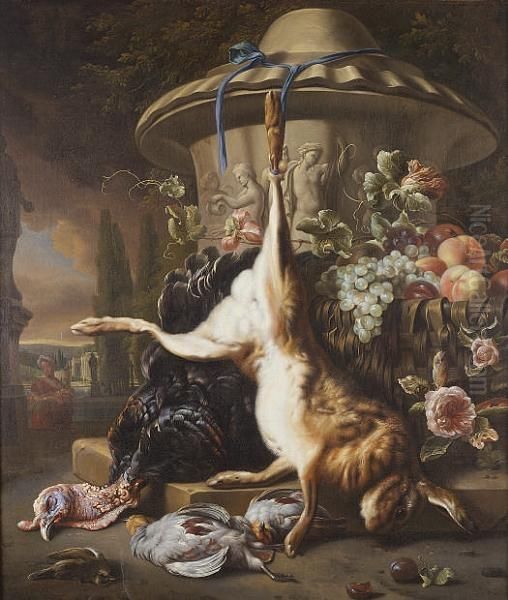
He was also adept at trompe-l'oeil (deceive the eye) effects. In works like Dead Partridge (or Dead Grouse), he painted the game bird, often hanging against a plain wall or niche, with such precision and shallow depth that it appears startlingly real, seemingly projecting out of the picture plane. This technique further demonstrated his technical virtuosity and aimed to delight and amaze the viewer. His hunting still lifes often included live hunting dogs, adding a dynamic element and narrative suggestion to the scenes of captured prey.
Landscapes and Portraits
While best known for his game pieces, Jan Weenix continued to produce other types of paintings throughout his career. He painted pure landscapes, often retaining the Italianate flavour inherited from his father. These scenes frequently feature classical ruins, pastoral figures, shepherds with their flocks, and the characteristic warm, golden light associated with Italy, even though they were likely composed in his Dutch studio based on sketches, prints, or his father's examples. An Italian Seaport (Rijksmuseum) exemplifies this genre, showcasing his ability to handle atmospheric perspective and architectural elements within a landscape setting.
An early work sometimes attributed to him, Italian Landscape with Shepherds (dated 1649), presents a potential chronological puzzle given his birth date around 1640. If correctly attributed and dated, it would suggest remarkable precocity. Alternatively, it might be a misattribution or an error in dating. Regardless, it points to the strong Italianate current present from the beginning of his artistic environment.
Weenix also undertook portraiture, although less frequently than still lifes. A notable example is the Family Group at the South Sea Port (c. 1670). This work combines portraiture with an elaborate Italianate harbour setting, demonstrating his versatility. The elegant figures are integrated into a complex scene filled with architectural details, ships, and background activity, showcasing a blend of genres typical of ambitious Dutch painting of the period.
Family, Collaborations, and Pupils
The Weenix family context remained important throughout Jan's life. His father, Jan Baptist, established a strong artistic reputation that Jan built upon. He was also related to other prominent artists. His cousin was Melchior d'Hondecoeter (1636–1695), arguably the most famous Dutch painter specializing exclusively in birds, both domestic and exotic, often depicted in lively scenes within park settings. Given their shared interest in animal and bird depiction, particularly within landscape contexts, it's likely they influenced each other, although direct collaboration documentation is scarce.
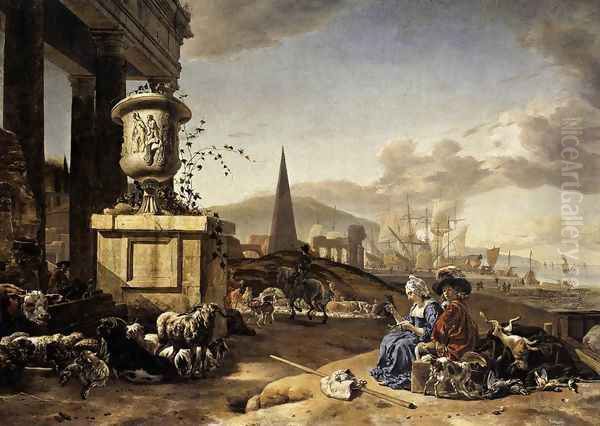
Unlike his prolific father who had several pupils, Jan Weenix is documented as having only one significant follower: Dirk Valkenburg (1675–1721). Valkenburg closely imitated Weenix's style, particularly the hunting still lifes, carrying his master's manner into the early 18th century. This suggests Weenix may have focused more intensely on his own highly successful production rather than extensive teaching.
The artistic environment in Amsterdam and Utrecht, where Weenix was primarily active, was vibrant and competitive. He worked alongside and competed with numerous other still life and landscape painters, constantly refining his technique and compositions to maintain his leading position in the market for luxurious decorative paintings.
Patronage and Reputation
Jan Weenix achieved considerable success during his lifetime, attracting a wealthy clientele. His elaborate game pieces and decorative landscapes were highly sought after by the affluent burghers of Amsterdam and Utrecht, who used them to adorn their elegant townhouses and country estates. The subject matter – the bounty of the hunt – resonated with aristocratic aspirations and symbolized wealth, status, and control over nature.
He received prestigious commissions, including a series of twelve very large canvases depicting hunting scenes and landscapes for the Elector Palatine Johann Wilhelm's hunting lodge, Schloss Bensberg, near Cologne (painted between 1702 and 1712). These works, now primarily housed in the Alte Pinakothek in Munich, represent the grand scale on which Weenix could operate and his favour among European nobility.
His reputation extended beyond the Netherlands. His meticulous technique and appealing subject matter earned him praise from contemporaries and later connoisseurs. The great German writer and polymath Johann Wolfgang von Goethe admired Weenix's ability to depict animals. Sir Joshua Reynolds, the first president of the Royal Academy in London, also acknowledged his skill. This recognition, coupled with the high prices his works commanded even during his lifetime and their continued activity in the art market, solidified his status.
Despite this success, his career may have faced challenges. The early death of his father around 1660, when Jan was still young, and potential financial difficulties within the family (some sources mention bankruptcy associated with Jan Baptist Weenix) could have presented obstacles. However, Jan Weenix evidently overcame these, establishing a long, productive, and highly successful independent career.
Later Career and Legacy
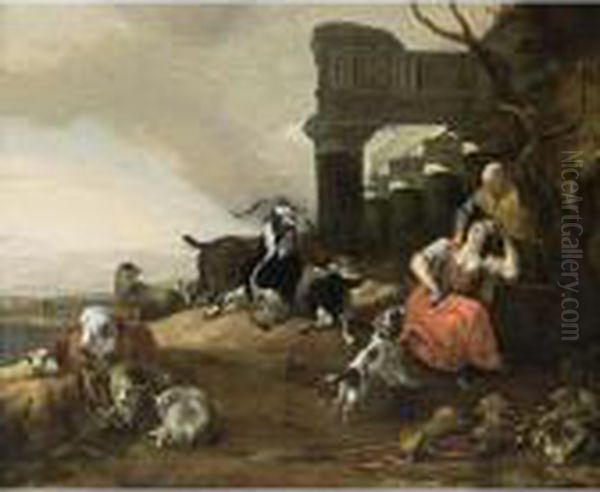
Jan Weenix remained active as a painter well into the 18th century, continuing to produce the hunting scenes and still lifes for which he was famous. He spent the later part of his career primarily in Amsterdam, where the market for luxury goods, including paintings, remained strong. He passed away in Amsterdam in September 1719 and was buried in the Nieuwezijds Kapel.
His legacy lies in his mastery of the game piece still life. He brought the genre to a peak of technical perfection and decorative elegance in the Dutch Golden Age. While tastes shifted after his death, his work has consistently been appreciated for its virtuosity and visual appeal. He successfully synthesized the detailed realism inherent in Dutch art with the grandeur and atmospheric qualities of the Italianate tradition learned from his father. His paintings offer a window into the opulent lifestyles and aesthetic preferences of the Dutch elite in the late 17th and early 18th centuries.
Weenix in Museum Collections
Today, Jan Weenix's paintings are held in major museum collections across the world, attesting to his enduring importance. Significant holdings can be found in:
The Rijksmuseum, Amsterdam: Houses key works like Dead Swan, A Hunting Still Life, An Italian Seaport, and A Seated Monkey.
The Amsterdam Museum: Holds works such as Still Life with Goose and Game before a Country Estate.
The Metropolitan Museum of Art, New York: Features examples like Still Life with Dead Heron.
The Nationalmuseum, Stockholm: Possesses hunting still lifes, including recent acquisitions.
The Wallace Collection, London: Holds several fine examples of his game pieces.
The Mauritshuis, The Hague: Contains important works.
Alte Pinakothek, Munich: Home to the large series painted for Schloss Bensberg.
Gemäldegalerie, Berlin: (Likely location for works listed under Pergamon Museum in the source).
Victoria and Albert Museum, London: Includes Weenix in its collection.
Museum of Fine Arts, Houston: Represents his work.
Detroit Institute of Arts: Holds examples of his paintings.
Kunsthalle Karlsruhe: Features his work.
Art Institute of Chicago: Includes Weenix in its European painting collection.
RISD Museum, Providence, Rhode Island: Holds works by Weenix.
Carnegie Museum of Art, Pittsburgh: Represents his oeuvre.
High Museum of Art, Atlanta: Includes his paintings.
Cleveland Museum of Art: Features his work.
Smart Museum of Art, University of Chicago: Holds examples.
This widespread distribution underscores the international appreciation for Weenix's artistry.
Art Historical Perspective
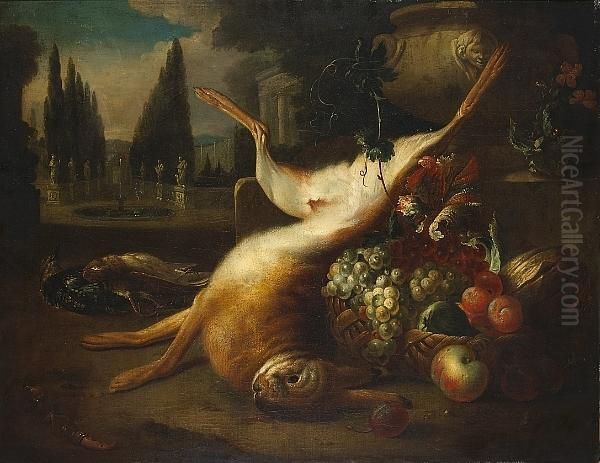
The art historical evaluation of Jan Weenix has evolved. Initially, particularly in the centuries immediately following his death, there might have been some confusion distinguishing his works, especially early Italianate pieces, from those of his father, Jan Baptist Weenix. Both artists signed their works similarly ("J. Weenix"), adding to the potential for misattribution.
However, modern scholarship has largely clarified these distinctions, allowing for a more nuanced understanding of Jan the Younger's development and specific contributions. His status as the leading master of the hunting still life in the later Dutch Golden Age is now firmly established. Art historians recognize his exceptional technical skill, his sophisticated compositions, and his role in catering to the tastes of the elite patron class of his time.
While sometimes criticized in periods that favoured less ostentatious or more morally charged art, his work is now appreciated for its sheer painterly quality, its decorative power, and its reflection of the cultural and social milieu of the Dutch Republic as it transitioned into the 18th century. He is seen not just as a follower of his father but as an independent master who significantly developed and refined his chosen specializations.
Conclusion
Jan Weenix remains a pivotal figure in Dutch art history, celebrated for bringing the genre of the hunting still life to an unprecedented level of refinement and opulence. His meticulous rendering of textures, rich colour palettes, and dramatic compositions captivated audiences in his own time and continue to impress viewers today. Bridging the detailed realism of the Dutch tradition with an Italianate sense of grandeur, Weenix created works that were both visually stunning and reflective of the status and tastes of his patrons. His paintings endure in major museums worldwide, testaments to a long and successful career dedicated to capturing the beauty, drama, and luxury associated with the natural world and the aristocratic pursuits of the Dutch Golden Age.